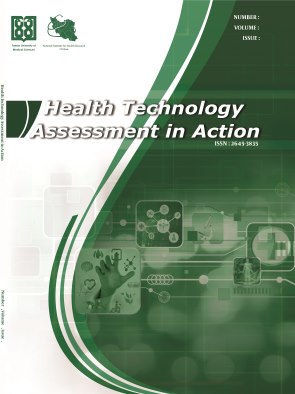Cost-effectiveness of Traditional Persian Medicine-Based Diet on Non-Alcoholic Fatty Liver Disease
Abstract
Background: In the context of Persian traditional medicine, there are several therapeutic strategies for managing diseases, ranging from lifestyle changes to herbal remedies.
Objectives: Given the application of Persian traditional medicine in the management of chronic diseases, the burden of chronic illnesses, and the public’s recourse to traditional medicine specialists, this study aimed to assess the cost-effectiveness of traditional medicine dietary regimens for the treatment of non-alcoholic fatty liver disease from the perspective of the payer.
Methods: In this study, we investigated the cost-effectiveness of providing nutrition counseling for lifestyle modification (changes in the aforementioned Setteh-e-Zarurieah) by a traditional medicine specialist compared to receiving counseling from a nutritionist for nonalcoholic fatty liver disease from the payer’s perspective. The outcomes measured were changes in aspartate aminotransferase (AST) and alanine aminotransferase (ALT) enzymes, body mass index (BMI), and the grade of fatty liver. Cost and effectiveness data were entered into Excel software, and the ICER ratio was calculated.
Results: The results indicated that the dietary regimen prescribed by Persian traditional medicine when compared to the nutritionist’s recommended diet, resulted in a lower decrease in AST and ALT enzymes but led to a greater decrease in BMI (mean change = 0.42) and a significant change in the grade of fatty liver (OR = 9.75). Since the costs of tests, ultrasounds, and visits were equal in both groups, the cost difference was zero. In the first scenario, where traditional medicine is considered an alternative therapy and liver enzymes are the
primary focus, providing nutritional counseling services by Persian traditional medicine may not be cost effective. However, if we consider the grade of fatty liver and BMI as the primary variables, providing nutritional counseling services by Persian traditional medicine may be cost-effective.
Conclusions: Based on the available evidence, the treatment of fatty liver using Persian traditional medicine can be considered an effective and cost-effective complementary (or alternative) intervention. Considering the long-term costs imposed by the health system and insurance organizations, it is predicted that adding visits to Persian traditional medicine specialists may reduce overall healthcare system costs.
2. Huang TD, Behary J, Zekry A. Non-alcoholic fatty liver disease: a review of epidemiology, risk factors, diagnosis and management. Intern Med J. 2020;50(9):1038-47. [PubMed ID:31760676]. https://doi.org/10.1111/imj.14709.
3. Suomela E, Oikonen M, Virtanen J, Parkkola R, Jokinen E, Laitinen T, et al. Prevalence and determinants of fatty liver in normalweight and overweight young adults. The Cardiovascular Risk in Young Finns Study. Ann Med. 2015;47(1):40-6. [PubMed ID:25333756].https://doi.org/10.3109/07853890.2014.966752.
4. Chalasani N, Younossi Z, Lavine JE, Charlton M, Cusi K, Rinella M, et al. The diagnosis and management of nonalcoholic fatty liver disease: Practice guidance from the American Association for the Study of Liver Diseases. Hepatology. 2018;67(1):328-57. [PubMed ID:28714183]. https://doi.org/10.1002/hep.29367.
5. Petta S, Di Marco V, Camma C, Butera G, Cabibi D, Craxi A. Reliability of liver stiffness measurement in non-alcoholic fatty liver disease: the effects of body mass index. Aliment Pharmacol Ther. 2011;33(12):1350-60. [PubMed ID:21517924]. https://doi.org/10.1111/ j.1365-2036.2011.04668.x.
6. Rogha M, Najafi N, Azari A, Kaji M, Pourmoghaddas Z, Rajabi F, et al. Non-alcoholic Steatohepatitis in a Sample of Iranian Adult Population: Age is a Risk Factor. Int J Prev Med. 2011;2(1):24-7. eng. [PubMed ID:21448401]. [PubMed Central ID:PMC3063465].
7. Amirkalali B, Poustchi H, Keyvani H, Khansari MR, Ajdarkosh H, Maadi M, et al. Prevalence of Non-Alcoholic Fatty Liver Disease and Its Predictors in North of Iran. Iran J Public Health. 2014;43(9):1275-83. eng. [PubMed ID:26175982]. [PubMed Central ID:PMC4500430].
8. Afsharipour M. [Non-alcoholic fatty liver disease and its complications from the perspective of Iranian traditional medicine and popular medicine]. Hist of Med. 2020;44(12):98-111. Persian.
9. Yao H, Qiao Y-J, Zhao Y-L, Tao X-F, Xu L-N, Yin L-H, et al. Herbal medicines and nonalcoholic fatty liver disease. World J Gastroenterol. 2016;22(30):6890. https://doi.org/10.3748/wjg.v22.i30.6890.
10. Peng H, He Y, Zheng G, Zhang W, Yao Z, Xie W. Meta-analysis of traditional herbal medicine in the treatment of nonalcoholic fatty liver disease. Cell Mol Biol (Noisy-le-grand). 2016;62(4):88-95. eng.[PubMed ID:27188741].
11. Liang Z, Chen X, Shi J, Hu H, Xue Y, Ung COL. Efficacy and safety of traditional Chinese medicines for non-alcoholic fatty liver disease: a systematic literature review of randomized controlled trials. Chin Med. 2021;16(1):9. [PubMed ID:33430929]. [PubMed Central ID:PMC7802307]. https://doi.org/10.1186/s13020-020-00422-x.
12. Gorji Z, Choopani R, Ghamarchehreh ME, Hekmatdoost A, Dehghan S. The recommended iranian traditional medicine (persian medicine) diet in non- alcoholic fatty liver disease. Indo Am J Pharm Sci. 2017;4(12):4551-62.
| Files | ||
| Issue | Vol 8 No 1 (2024) | |
| Section | Articles | |
| DOI | https://doi.org/10.18502/htaa.v8i1.15025 | |
| Keywords | ||
| Traditional Persian Medicine Non-Alcoholic Fatty Liver Cost-Effectiveness | ||
| Rights and permissions | |

|
This work is licensed under a Creative Commons Attribution-NonCommercial 4.0 International License. |




